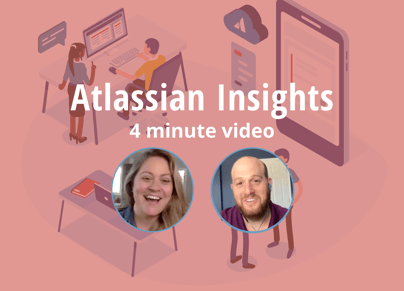There are two road mapping strategies Atlassian uses, basic and advanced. With either of these options, your team can still maximize the functionality of issue hierarchy, work effectively with transparency and more with the features of Cloud. Matter of fact, Atlassian is opening even more opportunities to teams in the marketplace and in Jira Premium by including advanced roadmaps into the bundle.
Click on the video above to hear how Ana Galofre and Michael Abdelnour explain the two road mapping options. Or skim through the transcription below.
Video Transcription
Ana: 00:01
Hey Mike.
Michael: 00:03
Hey, Ana.
Ana: 00:04
How are you today?
Michael: 00:07
I'm good. You know what we need, Ana?
Ana: 00:08
What?
Michael: 00:09
We need a fancy theme song for these videos.
Ana 00:13
That is correct.
Michael: 00:16
I'm going to put you to the task of writing our theme song.
Ana: 00:22
The lyrics or the music?
Michael: 00:25
Yes.
Ana: 00:26
Yes, both. Okay. All right.
Michael: 00:29
How are you?
Ana: 00:30
I'm great. I have a couple of questions for you about Portfolio for Jira actually.
Michael: 00:36
Go for it.
Ana: 00:37
Awesome. So as you know, I've been helping companies training and installing Portfolio for Jira for the last few years on server. I'm curious, with migration to Cloud, how all those features translate. I know Portfolio for Jira, the add-on doesn't exist anymore in Cloud and so I'm just wondering from like a feature parody and functionality, if all of that is still living in Cloud and what I can have my clients expect with that transition.
Michael: 01:15
Got it. Well, with Jira Cloud there's really two different main ways of road mapping. We will call them basic road mapping and we'll call it advanced road mapping. And as you put it, Portfolio for Jira, has been rebranded as advanced road mapping. And so let me ask you before we get into some more details, what are some of your favorite features of [crosstalk 00:01:44] the tool so far?
Ana: 01:46
Well, I would say number one, which sounds like the simple thing is the issue hierarchy. So just being able to see in one place, I'm a very visual person, sort of parent-child relationships all the way down, that work breakdown structure. So whether you have an initiative and then maybe another level an Epics and tasks and sub-tasks, to be able to see that whole breakdown in one place. So I'm assuming that's going to live on.
Ana: 02:15
And then I would say obviously just the Gantt chart functionality. So basic road mapping, not having a separate PMO tool where you're translating everything over, but taking that real-time work that's done, over multiple teams, multiple projects, being able to see that roadmap and Gantt chart in one place charting the progress. So whether that's like how many tasks are done for a certain Epic, how many hours are done towards a certain estimation, being able to see that visually is huge. Dependencies is a big thing that my clients are always looking for. So what are the blockers? What are these issues being blocked by? That's another big one. Are all of those present in ...
Michael: 03:03
Well, the great news is that all of those are in the Cloud features. And I think the biggest differentiation between advanced and basic is really, I guess it's in the name for lack of a better word, but basic is, you could think of it as an isolated team. It's a great roadmap for a single Jira project for using one team. And advanced roadmaps is much more with some of the stuff that you were describing, the team of teams, the interdependencies between teams, maybe how progress on one team is actually impacting progress on another team. Some of that more complex view is much more in the advanced roadmaps. And so what we've done is we have a pretty good approach at how we would recommend teams to go into either advanced or basic, or maybe even an add-on. There are even more opportunities out there in the marketplace.
Ana: 03:59
Okay. [crosstalk 00:04:00]. Is advanced roadmaps still an add-on, or is that bundled into the core product now?
Michael: 04:09
Yeah, it's a great question. It's actually bundled into the Jira premium offering. So if you're looking for that, it's part of the premium offering now. So it's no longer an add-on you get separately. It's baked right in as part of the offering, it is part of the premium package. But I think when you get to that team of teams approach and that team of teams visibility that we're talking about, I think there's some other features in that premium offering.
Ana: 04:34
Okay, it's more than high level ...
Michael: 04:35
It's built right in, it's not a separate cost. It's not something else you have to manage.
Ana: 04:40
Well good. More training opportunities for me. I love it.
Michael: 04:42
Absolutely.
Ana: 04:43
Awesome. Thanks for your time, Mike. I really appreciate it.
Michael: 04:46
No problem. Great question today.
Ana: 04:47
Thanks.
Michael: 04:47
Talk to you soon.
Ana: 04:47
Talk to you soon. Bye.
E7 Solutions' Advisory Services provide the expertise and guidance you need to unlock the power of Atlassian. With three different solutions offered, our team of experts will ensure that your Atlassian projects align with your business objectives and drive success.






.png?width=300&height=115&name=New%20Project%20(1).png)

